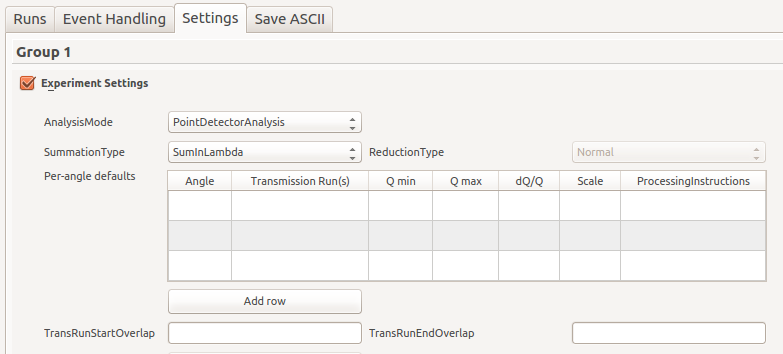\(\renewcommand\AA{\unicode{x212B}}\)
Reflectometry Changes
- The following new options have been added to the Settings tab:
- A new table has been added to the Experiment settings which allows default options to be specified on a per-angle basis. If a row in the Runs tab contains an angle, it will be looked up in this table and those options will be used if a matching angle is found (the angle does not have to be exact as it will match to within 100th of a degree). If you want to specify values that will be used by default for all runs, then simply leave the angle empty.
- Two new drop-down boxes have been added to the Experiment settings, ‘ReductionType’ and ‘SummationType’, which are passed to the corresponding parameters of ReflectometryReductionOneAuto v3.
- A ‘CorrectDetectors’ check box has been added to the Instrument settings, which maps to the corresponding property in ReflectometryReductionOneAuto v3.
- The ‘Get Defaults’ button now looks for values for the following additional properties in the IDF:
- AnalysisMode
- PolarizationAnalysis
- TransRunStartOverlap
- TransRunEndOverlap
- IntegratedMonitors
- DetectorCorrectionType
- CorrectDetectors
- SummationType
- ReductionType
- There is a new checkbox on the SaveASCII tab which automatically saves the ‘IvsQ_binned’ workspace for single row reductions and the stitched workspace for group reductions.
- Output workspace names and plotting:
- Output workspace names now use
+ to indicate preprocessed (i.e. summed) workspaces, rather than _, which is used to indicate postprocessed (i.e. stitched) workspaces.
- Output workspace names for time sliced data now contain the time periods, rather than just a slice index number.
- Plotting results in event handling mode now plots the
IvsQ_binned_ workspaces rather than IvsQ_, to make the behaviour consistent with non-event mode.
- The Python code generated when you tick
Output Notebook has been improved to support special characters (e.g. +) in workspace names.
- The
Output Notebook option now works for all groups that are processed as non-event workspaces. Previously, if event handling was enabled but a group contained non-event workspaces, generating the notebook was not performed.
- Properties on the Runs tab now take precedence over properties on the Settings tab.
- Extra tooltips have been added along with a new
? button which links to the documentation page.
- The runs tab table now contains grid lines to make it easier to see where to enter text.
- Menu items and toolbar buttons are now enabled/disabled when appropriate, e.g. to prevent table modification during processing. Directly editing table rows and settings is also disabled during processing.
- The ‘DirectBeam’ box has been from the settings tab because this is not used.
- Fixed some bugs where transmission runs entered on the Settings tab were not being found, whether entered as a run number to load or as the name of an existing workspace in the ADS.
- The Python code generated when you tick
Output Notebook has been changed so that all algorithm property values are enclosed in quotes. Unquoted values were causing failures in some algorithms. A bug has also been fixed in setting the legend location for the 4th (stitched) plot, which is shown when post-processing is performed.
- If any of the mandatory parameters listed below are missing when pressing ‘Get Default’ a warning is shown rather than a crash.
- MonitorIntegralMax
- MonitorIntegralMin
- MonitorBackgroundMin,
- MonitorBackgroundMax,
- LambdaMin,
- LambdaMax,
- I0MonitorIndex
- TransRunStartOverlap and TransRunEndOverlap if on SURF or CRISP.
- Fixed a bug where the processed state of rows was being reset when transferring additional rows into the table.
- The REFL Reduction, REFL SF Calculator and REFM Reduction graphical interface have been removed, they were not in active use, and were a source of bugs as well as using testing effort that is better directed elsewhere.
- Improvements to LoadILLReflectometry v1:
- Figaro NeXus files are now properly handled.
- A new property, BeamCentre allows user to manually specify the beam position on the detector.
- The BeamPosition property was renamed to DirectBeamPosition to better reflect its usage.
- The BraggAngle property of LoadILLReflectometry v1 now works as expected: the detector will be rotated such that the reflected peak on the detector will be at twice BraggAngle.
- Slits S2 and S3 have been added to D17 and Figaro IDFs; the loader will adjust their positions according to the NeXus files.
- The MagnetismReflectometryReduction now computes a Q-resolution estimate based on slit openings.
- Removed the
RegionOfDirectBeam property from ReflectometryReductionOne v2 and ReflectometryReductionOneAuto v3 because this is not used.
